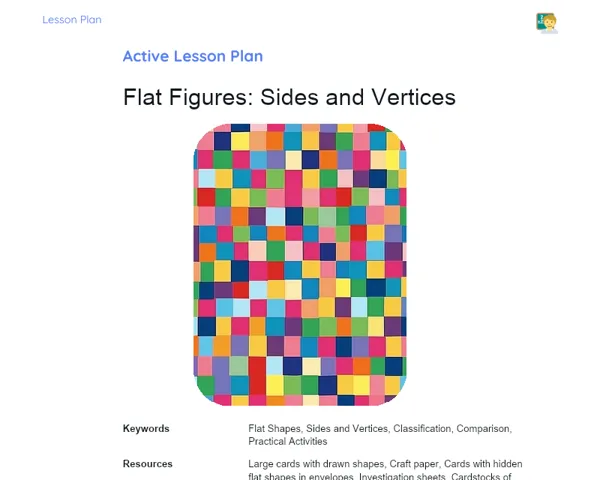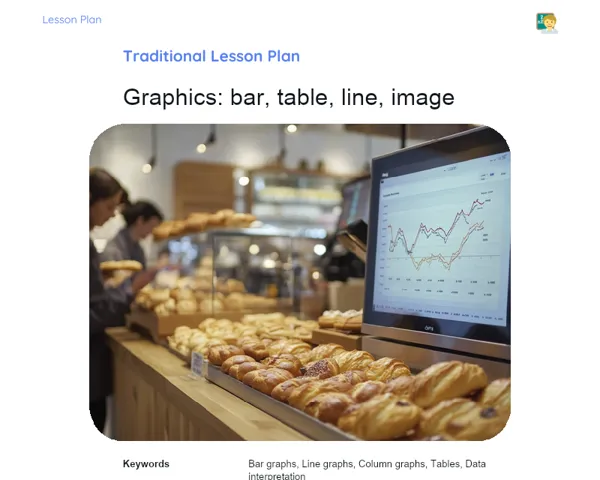Lesson Plan | Lesson Plan Tradisional | Spatial Geometry: Surface Area of the Pyramid
| Keywords | Spatial Geometry, Surface Area, Pyramid, Lateral Area, Total Area, Area Calculation, Geometric Formulas, Practical Examples, Problem Solving |
| Resources | Whiteboard, Markers, Image or 3D model of a pyramid, Calculators, Paper and pens for notes, Worksheets, Rulers and compasses, Visual aids (slides or posters) |
Objectives
Duration: (10 - 15 minutes)
The goal of this stage is to introduce Spatial Geometry, with a focus on the surface area of a pyramid. It's essential to give students a clear overview of the skills they'll acquire during the lesson. This foundation is crucial for helping them grasp the concepts and methods we'll delve into, ensuring they understand the learning outcomes and why this topic is relevant.
Objectives Utama:
1. Calculate the lateral surface area of a pyramid.
2. Calculate the total surface area of a pyramid.
3. Solve problems involving the calculation of both lateral and total areas of a pyramid.
Introduction
Duration: (10 - 15 minutes)
📚 Purpose: This part aims to introduce Spatial Geometry, specifically the surface area of a pyramid, while outlining the skills students will develop throughout the lesson. It sets the stage for learning the methods and ensures that students understand the learning goals and the importance of the content.
Did you know?
🤔 Curiosity: Did you know that the Egyptian pyramids were constructed over 4,500 years ago and remain one of the Seven Wonders of the World? Moreover, building these majestic structures required a sophisticated understanding of geometry and mathematics, particularly for calculating surface areas. Grasping pyramid geometry helps us appreciate the brilliance of these ancient achievements and their relevance today in fields like architecture and civil engineering.
Contextualization
🚀 Context: Kick off the lesson by showing students an image or a 3D model of a pyramid, like the iconic Great Pyramid of Giza in Egypt. Clarify that a pyramid is a three-dimensional shape with a polygonal base and triangular sides converging at a point called the vertex. Mention that pyramids are seen in numerous ancient cultures and had various uses, like monuments, tombs, and temples.
Concepts
Duration: (50 - 60 minutes)
📖 Purpose: This stage aims to reinforce students' understanding of calculating pyramid surface areas through thorough explanations and practical examples. It is essential to ensure students can accurately apply the formulas and tackle various related problems.
Relevant Topics
1. 📏 Definition of Pyramid: Explain that a pyramid is a geometric figure with a polygonal base and triangular faces that converge at a common vertex.
2. 📘 Formulas for Area Calculation: Discuss the formulas used to determine both the lateral surface area and total surface area of a pyramid. The lateral area formula is the sum of the triangular face areas, while the total area combines the base area with the lateral area.
3. 🔍 Practical Examples: Provide real examples of surface area calculations for different types of pyramid bases (triangular, square, etc.) and demonstrate how to implement the formulas for each scenario.
4. 🛠️ Guided Problem Solving: Address typical problems that involve figuring out both lateral and total areas of pyramids, demonstrating the process step by step. Motivate students to actively participate and record each part of the procedure.
To Reinforce Learning
1. Calculate the lateral area of a pyramid with a square base, where each side measures 4 cm and the height of the triangular face is 6 cm.
2. A pyramid features a triangular base with sides measuring 3 cm, 4 cm, and 5 cm, and a height of 7 cm. Calculate the total surface area.
3. Determine the total surface area of a pyramid with a regular hexagonal base, where each side is 2 cm and the height of each triangular face is 5 cm.
Feedback
Duration: (15 - 20 minutes)
🔍 Purpose: This stage aims to solidify students' understanding by allowing them to review and discuss the solutions to the problems presented. This period of reflection and discussion is critical for identifying and correcting any difficulties, while also enhancing comprehension of the concepts covered.
Diskusi Concepts
1. Calculate the lateral area of a pyramid with a square base, where each side measures 4 cm and the height of each triangular face is 6 cm.
To find the lateral area, start by calculating the area of one triangular face:
Area of one triangular face = (base × height) / 2 = (4 cm × 6 cm) / 2 = 12 cm².
Since the pyramid has 4 triangular faces, the lateral area is:
Lateral area = 4 × 12 cm² = 48 cm². 2. A pyramid has a triangular base with sides of 3 cm, 4 cm, and 5 cm, and a height of 7 cm. Calculate the total surface area.
First, use Heron's formula to find the base area:
Semiperimeter (s) = (3 cm + 4 cm + 5 cm) / 2 = 6 cm.
Area of the base = √[s(s - a)(s - b)(s - c)] = √[6(6 - 3)(6 - 4)(6 - 5)] = √[6 × 3 × 2 × 1] = √36 = 6 cm².
Now, find the area of each triangular face. Assuming the height is 7 cm:
Area of each triangular face = (base × height) / 2.
Areas of the triangular faces:
Face 1: (3 cm × 7 cm) / 2 = 10.5 cm². Face 2: (4 cm × 7 cm) / 2 = 14 cm². Face 3: (5 cm × 7 cm) / 2 = 17.5 cm².
Lateral area = 10.5 cm² + 14 cm² + 17.5 cm² = 42 cm².
Total area = Base area + Lateral area = 6 cm² + 42 cm² = 48 cm². 3. Determine the total surface area of a pyramid with a regular hexagonal base, where each side measures 2 cm and the height of each triangular face is 5 cm.
First, calculate the area of the hexagonal base. The formula for the area of a regular hexagon is:
Area of the base = (3√3 / 2) × L², where L is the length of the side.
Area of the base = (3√3 / 2) × (2 cm)² = (3√3 / 2) × 4 cm² = 6√3 cm².
Next, calculate the area of each triangular face:
Area of one triangular face = (base × height) / 2 = (2 cm × 5 cm) / 2 = 5 cm².
Since the pyramid has 6 triangular faces, the lateral area is:
Lateral area = 6 × 5 cm² = 30 cm².
Total area = Base area + Lateral area = 6√3 cm² + 30 cm².
Engaging Students
1. 📌 Questions and Reflections: 2. Did you have any challenges when using Heron's formula for the triangular base area? If yes, what were they? 3. How does the height of the triangular faces affect the lateral area calculation? Explain in your own terms. 4. Compare how complex it is to calculate the area for a pyramid with a square base versus one with a hexagonal base. Which did you find more difficult and why? 5. In what real-life situations do you think knowing how to calculate the surface area of pyramids could come in handy?
Conclusion
Duration: (5 - 10 minutes)
📜 Purpose: This final stage focuses on reviewing and consolidating the lesson's content to ensure students grasp the key concepts and their practical implications. It also highlights the significance of the topic and its relevance in various contexts.
Summary
['Definition of a pyramid as a geometric figure with a polygonal base and triangular faces that meet at a common vertex.', 'Formulas for calculating the lateral surface area (sum of the areas of the triangular faces) and the total area (base area plus lateral area) of a pyramid.', 'Real-life examples of surface area calculations for pyramids with various bases (triangular, square, hexagonal).', 'Guided problem-solving involving the calculation of lateral and total areas of pyramids.']
Connection
The lesson linked theoretical knowledge with practical application, showcasing mathematical formulas and their usage in real-world scenarios. Students could see how the abstract ideas of spatial geometry translate into tangible problem-solving, thereby aiding their understanding and application of the studied formulas.
Theme Relevance
Knowing how to calculate the surface area of pyramids is essential in various fields, including architecture, civil engineering, and even history when analysing ancient construction techniques. Additionally, this skill proves practical for resolving everyday challenges that involve area and volume calculations, such as in construction and design projects.



